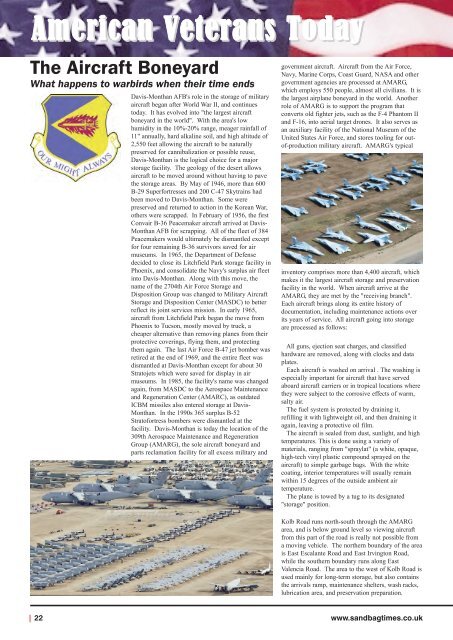You also want an ePaper? Increase the reach of your titles
YUMPU automatically turns print PDFs into web optimized ePapers that Google loves.
American Veterans Today<br />
<strong>The</strong> Aircraft Boneyard<br />
What happens to warbirds when their time ends<br />
Davis-Monthan AFB's role in the storage of military<br />
aircraft began after World War II, and continues<br />
today. It has evolved into "the largest aircraft<br />
boneyard in the world". With the area's low<br />
humidity in the 10%-20% range, meager rainfall of<br />
11" annually, hard alkaline soil, and high altitude of<br />
2,550 feet allowing the aircraft to be naturally<br />
preserved for cannibalization or possible reuse,<br />
Davis-Monthan is the logical choice for a major<br />
storage facility. <strong>The</strong> geology of the desert allows<br />
aircraft to be moved around without having to pave<br />
the storage areas. By May of 1946, more than 600<br />
B-29 Superfortresses and 200 C-47 Skytrains had<br />
been moved to Davis-Monthan. Some were<br />
preserved and returned to action in the Korean War,<br />
others were scrapped. In February of 1956, the first<br />
Convair B-36 Peacemaker aircraft arrived at Davis-<br />
Monthan AFB for scrapping. All of the fleet of 384<br />
Peacemakers would ultimately be dismantled except<br />
for four remaining B-36 survivors saved for air<br />
museums. In 1965, the Department of Defense<br />
decided to close its Litchfield Park storage facility in<br />
Phoenix, and consolidate the Navy's surplus air fleet<br />
into Davis-Monthan. Along with this move, the<br />
name of the 2704th Air Force Storage and<br />
Disposition Group was changed to Military Aircraft<br />
Storage and Disposition Center (MASDC) to better<br />
reflect its joint services mission. In early 1965,<br />
aircraft from Litchfield Park began the move from<br />
Phoenix to Tucson, mostly moved by truck, a<br />
cheaper alternative than removing planes from their<br />
protective coverings, flying them, and protecting<br />
them again. <strong>The</strong> last Air Force B-47 jet bomber was<br />
retired at the end of 1969, and the entire fleet was<br />
dismantled at Davis-Monthan except for about 30<br />
Stratojets which were saved for display in air<br />
museums. In 1985, the facility's name was changed<br />
again, from MASDC to the Aerospace Maintenance<br />
and Regeneration Center (AMARC), as outdated<br />
ICBM missiles also entered storage at Davis-<br />
Monthan. In the 1990s 365 surplus B-52<br />
Stratofortress bombers were dismantled at the<br />
facility. Davis-Monthan is today the location of the<br />
309th Aerospace Maintenance and Regeneration<br />
Group (AMARG), the sole aircraft boneyard and<br />
parts reclamation facility for all excess military and<br />
government aircraft. Aircraft from the Air Force,<br />
Navy, Marine Corps, Coast Guard, NASA and other<br />
government agencies are processed at AMARG,<br />
which employs 550 people, almost all civilians. It is<br />
the largest airplane boneyard in the world. Another<br />
role of AMARG is to support the program that<br />
converts old fighter jets, such as the F-4 Phantom II<br />
and F-16, into aerial target drones. It also serves as<br />
an auxiliary facility of the National Museum of the<br />
United States Air Force, and stores tooling for outof-production<br />
military aircraft. AMARG's typical<br />
inventory comprises more than 4,400 aircraft, which<br />
makes it the largest aircraft storage and preservation<br />
facility in the world. When aircraft arrive at the<br />
AMARG, they are met by the "receiving branch".<br />
Each aircraft brings along its entire history of<br />
documentation, including maintenance actions over<br />
its years of service. All aircraft going into storage<br />
are processed as follows:<br />
All guns, ejection seat charges, and classified<br />
hardware are removed, along with clocks and data<br />
plates.<br />
Each aircraft is washed on arrival . <strong>The</strong> washing is<br />
especially important for aircraft that have served<br />
aboard aircraft carriers or in tropical locations where<br />
they were subject to the corrosive effects of warm,<br />
salty air.<br />
<strong>The</strong> fuel system is protected by draining it,<br />
refilling it with lightweight oil, and then draining it<br />
again, leaving a protective oil film.<br />
<strong>The</strong> aircraft is sealed from dust, sunlight, and high<br />
temperatures. This is done using a variety of<br />
materials, ranging from "spraylat" (a white, opaque,<br />
high-tech vinyl plastic compound sprayed on the<br />
aircraft) to simple garbage bags. With the white<br />
coating, interior temperatures will usually remain<br />
within 15 degrees of the outside ambient air<br />
temperature.<br />
<strong>The</strong> plane is towed by a tug to its designated<br />
"storage" position.<br />
Kolb Road runs north-south through the AMARG<br />
area, and is below ground level so viewing aircraft<br />
from this part of the road is really not possible from<br />
a moving vehicle. <strong>The</strong> northern boundary of the area<br />
is East Escalante Road and East Irvington Road,<br />
while the southern boundary runs along East<br />
Valencia Road. <strong>The</strong> area to the west of Kolb Road is<br />
used mainly for long-term storage, but also contains<br />
the arrivals ramp, maintenance shelters, wash racks,<br />
lubrication area, and preservation preparation.<br />
| 22 www.sandbagtimes.co.uk


















